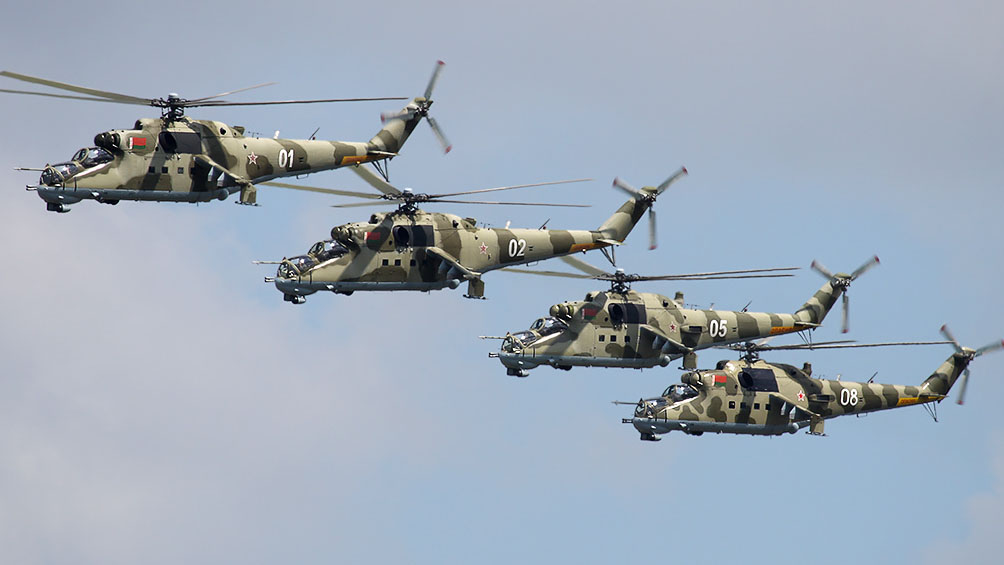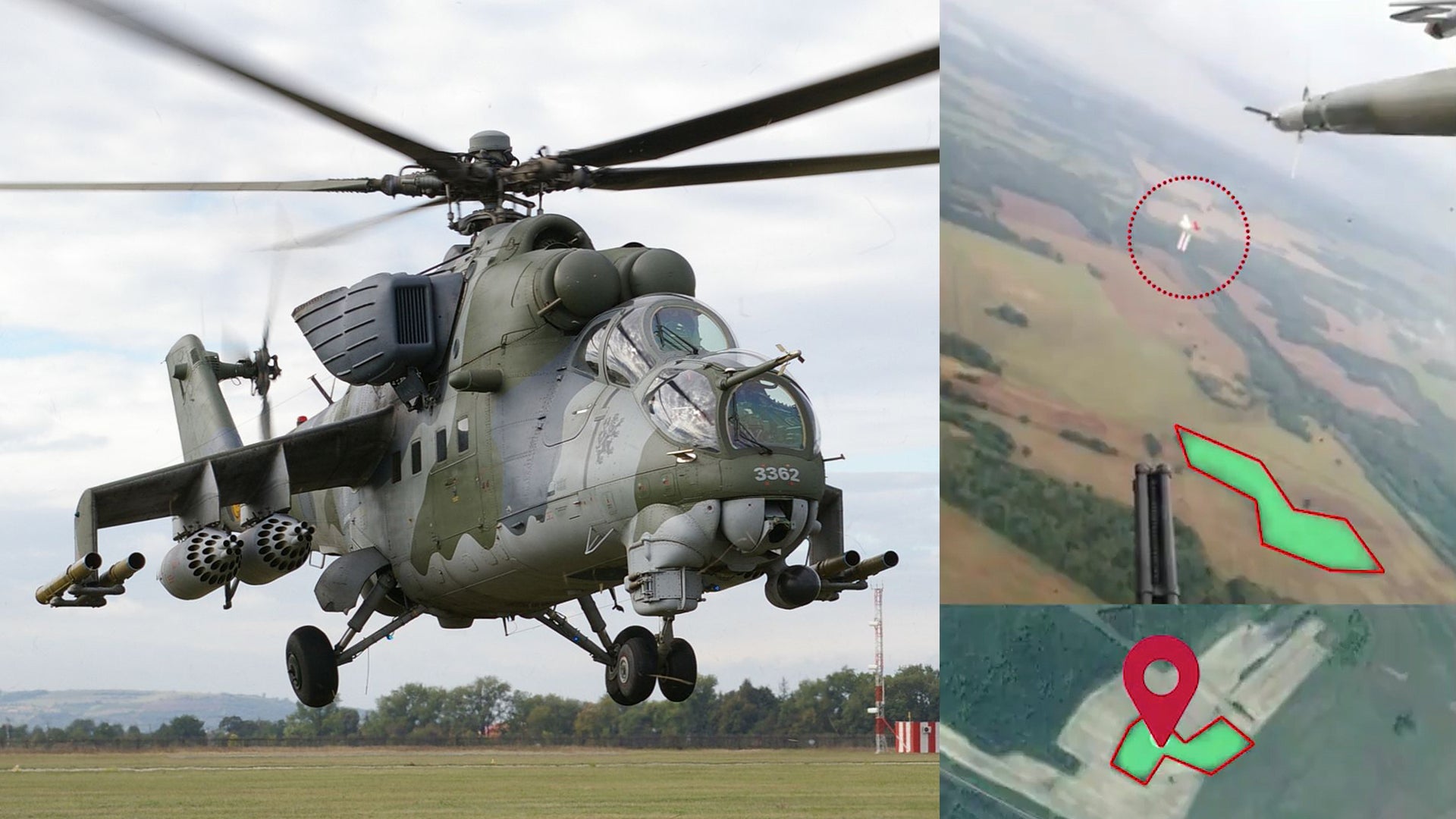A video posted to Twitter and reportedly sourced from the Ministry of Defense of Belarus appears to show footage from the front cockpit of a Mi-24 Hind helicopter gunship as it wards off a balloon carrying a red-and-white banner that has become a regular sight at recent demonstrations staged by those opposed to the authoritarian president of Belarus, Alexander Lukashenko. Often called Europe’s last dictator, Lukashenko has become increasingly embattled following a purported landslide re-election earlier this month that has been widely denounced as fraudulent and sparked major protests.
The Ministry of Defense of Belarus reportedly scrambled the Mi-24 on the evening of August 23, 2020, to intercept balloons, which it said were carrying what it described as “anti-state symbols.” The flag in question was the country’s official one between 1991 and 1995. The current red-and-green design is based on the flag that Belarus used when it was a Soviet Republic.
“Thanks to the crews of Mi-24 helicopters the balloons’ flight was intercepted without recourse to weapons,” the Ministry of Defense added in a statement, claiming that the eight balloons had launched from neighboring Lithuania and were attempting to violate Belarusian airspace. According to a report in the Lithuanian media, one of the eight balloons was carrying a 50-foot red-and-white flag.
The reported “provocation” occurred near the village of Volkovshchina in the Ashmyany district, the Ministry of Defense of Belarus claims. This western district borders Lithuania and is only around 25 miles from the Lithuanian capital, Vilnius.
At the same time, the Lithuanian Foreign Ministry says it has summoned the Belarusian ambassador as it protests an alleged violation of its airspace by the Belarusian Mi-24.
The day the incident happened, the beleaguered Lukashenko was filmed in military fatigues and carrying an assault rifle as he arrived at the presidential palace by VIP helicopter. You can read more about the bizarre scene here.
Different news sources quoted Lithuanian Foreign Minister Linas Linkevičius, who confirmed the protest against the Belarusian actions had been lodged and that the Hind had been sighted near Medininkai, a Lithuanian town close to the border. “It was seen visually,” he said. “We have all the information from our air traffic controllers [confirming] that there has been a violation,” Linkevičius added.
Further details of the incident from the Belarusian side were provided by Colonel Oleg Orlov, Acting Deputy Commander of the Belarusian Air Force and Air Defense Forces, in an interview published by BelTA, the country’s official news agency. “These seemingly harmless balloons pose a threat to flight safety, including to civil aviation,” he explained. “No one knows what the payloads of these balloons are — they could be carrying explosives, toxic substances, and so on.” Colonel Orlov stressed that his pilots had acted in accordance with international law and that they had not crossed the border into Lithuania.

The Belarusian Air Force and Air Defense Forces currently operate Soviet-era Mi-24s from a single location, Machulishchy, near the capital Minsk, which is home to the 50th Mixed Aviation Base. This is situated around 37 miles from the scene of the alleged incident in Volkovshchina.
While a range of Mi-24P, Mi-24K, and Mi-24R aircraft are active in Belarus, the video clearly reveals a turret-mounted 12.7mm caliber machine gun, indicating it’s a Mi-24K or Mi-24R, which were originally developed as artillery correction and NBC (nuclear, biological, chemical) reconnaissance versions respectively. The country’s older Mi-24V helicopters are thought to be in storage. It’s also noteworthy that the Belarusian Ministry of Defense also just announced a contract for four Mi-35Ms — thoroughly modernized versions of the original Hind.
On the same date as the reported Mi-24 incident, as many as 50,000 people linked hands in Lithuania to form a human chain from Vilnius to the Belarusian border. The show of solidarity with the Belarus opposition echoed previous human chains that appeared in Lithuania, Latvia, and Estonia as the Baltic States sought independence from the Soviet Union beginning in 1989.
It’s worth noting, too, that Belarus has a previous history of downing balloons in its airspace. In September 1995, around a year after Lukashenko first took office, the Belarusian Air Defense Forces shot down a balloon and killed its two American pilots after they drifted off course during a race and crossed the border from Poland. The gas balloon was downed by a helicopter gunship near the town of Bereza, in the Brest region along the border with Poland.
According to the air force commander who gave the order to shoot back in 1995, the balloonists failed to respond to radio calls and warning shots, and the balloon was then determined to be an unmanned reconnaissance balloon. Spy balloons of this type had been regularly intercepted by Soviet air defenses during the Cold War.
In 2012, Lukashenko himself called for a harder line to be taken against aerial intruders. “Unlawful violations of state borders must not be allowed,” he explained. “They must be stopped by all force and means, including weapons, regardless of anything.” His words were in response to a flight be a Swedish light aircraft, which had dropped 800 teddy bears near the town of Ivyanets in a pro-democracy stunt after crossing into Belarusian airspace from Lithuania.
Episodes like that in 1995 show just how quickly apparently innocent flights can escalate to become international incidents. And with tensions around Belarus showing no signs of abating, the chances of the country’s air defenses assuming a more aggressive posture against any other “intruders” — whether deliberate or otherwise — seems likely.
Contact the author: thomas@thedrive.com
